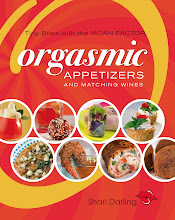 Fried onions, bread and panko crumbs, chopped toasted nuts, crushed potato chips, crumpled bacon and shredded or grated cheese all serve as flavourful and textured toppings for your next casserole entree.
Fried onions, bread and panko crumbs, chopped toasted nuts, crushed potato chips, crumpled bacon and shredded or grated cheese all serve as flavourful and textured toppings for your next casserole entree.The casserole is one of North America’s favourite styles of cookery and is certainly an easy-to-prepare comfort food.
Being a comfort food, casseroles do not require expensive vintages as partners -- unless they contain expensive ingredients, such as venison or lobster. An easy drinking white or red wine under $15.00 will perform nicely.
First, let’s look at the word “casserole.” It is a French term that defines the dish used for baking. (This word was first printed in English in 1708.) In the 50’s, when lightweight metal and glass bake-ware were introduced, casserole cookery became popular in North America.
Today, the word casserole refers to both the “baking dish” and the “food inside the baking dish.” The dish itself is a deep, round, ovenproof container with handles and a tightly-fitting lid, made of glass, metal, ceramic or any heatproof material. You can serve a casserole for breakfast, as a side dish, or as a main entree.
Ingredients can include cooked meats, poultry, fish, eggs, and vegetables, usually "bound" together with some kind of sauce or soup. The dish is often topped with one of a variety of toppings, as suggested above. Garnishes include tomato wedges, shredded lettuce, pimiento-stuffed olives, fresh parsley or other herbs, sliced hard-boiled eggs, or sliced green onions.
The nifty thing about the casserole is that it can be frozen in its own dish, cooked or uncooked. (However, consume within two months.) If you’re freezing a cooked casserole, let cool to room temperature before freezing. Be sure to line the baking dish with aluminum foil, leaving enough overhanging foil to cover the top for freezing. Seal the casserole in a heavy-duty freezer bag. And don’t forget to label and date the bag. Before heating up, thaw the casserole in the refrigerator overnight and heat at 350 F until hot.
Now for the casserole's best wine partners ...
You increase your chances of creating a harmonious partnership if you pair the wine with the casserole according to their similar and predominant taste sensations -- which I call “building blocks.”`
Tangy tasting casseroles using a base ingredient like yogurt or sour cream or salty ones with smoked salmon or capers work well with crisp, dry white wines. I love a Middle Eastern chicken casserole with garlic, lemon and yogurt called Fete. It tastes lovely with Sauvignon Blanc. Smoked salmon and dill casserole or crab and artichoke casserole works with Pinot Grigio, Sauvignon Blanc, dry Riesling, Vinho Verde, or Verdicchio.
artichoke casserole works with Pinot Grigio, Sauvignon Blanc, dry Riesling, Vinho Verde, or Verdicchio.
Tangy tasting casseroles using a base ingredient like yogurt or sour cream or salty ones with smoked salmon or capers work well with crisp, dry white wines. I love a Middle Eastern chicken casserole with garlic, lemon and yogurt called Fete. It tastes lovely with Sauvignon Blanc. Smoked salmon and dill casserole or crab and
 artichoke casserole works with Pinot Grigio, Sauvignon Blanc, dry Riesling, Vinho Verde, or Verdicchio.
artichoke casserole works with Pinot Grigio, Sauvignon Blanc, dry Riesling, Vinho Verde, or Verdicchio. Casseroles with sweetness (containing yams or fresh fruit) or  hot and spiciness demand off-dry (semi-sweet) whites like Gewurztraminer or Riesling offering a hint of sweetness. (Make sure that the wine is sweeter than the yams or fruit in the casserole. Otherwise, the interaction of food with the wine will make the wine taste too tart.) Squash casserole and an off dry Riesling taste great together. Cajun shrimp casserole works well with an off dry Gewurztraminer. An off dry rose with a hint of sweetness harmonizes with either corn and green chili tamale or layered enchilada casserole.
hot and spiciness demand off-dry (semi-sweet) whites like Gewurztraminer or Riesling offering a hint of sweetness. (Make sure that the wine is sweeter than the yams or fruit in the casserole. Otherwise, the interaction of food with the wine will make the wine taste too tart.) Squash casserole and an off dry Riesling taste great together. Cajun shrimp casserole works well with an off dry Gewurztraminer. An off dry rose with a hint of sweetness harmonizes with either corn and green chili tamale or layered enchilada casserole.
 hot and spiciness demand off-dry (semi-sweet) whites like Gewurztraminer or Riesling offering a hint of sweetness. (Make sure that the wine is sweeter than the yams or fruit in the casserole. Otherwise, the interaction of food with the wine will make the wine taste too tart.) Squash casserole and an off dry Riesling taste great together. Cajun shrimp casserole works well with an off dry Gewurztraminer. An off dry rose with a hint of sweetness harmonizes with either corn and green chili tamale or layered enchilada casserole.
hot and spiciness demand off-dry (semi-sweet) whites like Gewurztraminer or Riesling offering a hint of sweetness. (Make sure that the wine is sweeter than the yams or fruit in the casserole. Otherwise, the interaction of food with the wine will make the wine taste too tart.) Squash casserole and an off dry Riesling taste great together. Cajun shrimp casserole works well with an off dry Gewurztraminer. An off dry rose with a hint of sweetness harmonizes with either corn and green chili tamale or layered enchilada casserole. Rich seafood casseroles need a big, fat wine match like a luscious barrel-fermented and/or aged Chardonnay or barrel-fermented Sauvignon Blanc, referred to as “Fume Blanc.” Scallop and potato or lobster and potato  casserole highlighted with lemon garlic butter is divine when served with a big fat white.
casserole highlighted with lemon garlic butter is divine when served with a big fat white.
 casserole highlighted with lemon garlic butter is divine when served with a big fat white.
casserole highlighted with lemon garlic butter is divine when served with a big fat white.Choose a light, fruity red, such as Pinot Noir for fresh, wild salmon or tuna-based casseroles.
Casseroles containing highly textured red meats or bitter tasting ingredients, such as spinach and nuts, complement a red wine with some pleasant bitterness, such as a medium to full-bodied Cabernet Sauvignon or Meritage, both offering sufficient bitterness from the present tannins. Casseroles that work with big reds include lamb and pasta and potato with gouda and bacon.
So, the next time you think casserole, think wine!





I would never have thought of pairing wine with casseroles. Ever. But this makes complete sense.
ReplyDeleteAccording to trend expert Dana McCauley, casseroles are making a comeback:
http://danamccauley.wordpress.com/2009/04/15/return-of-the-casserole/
I've never been much of a casserole fan, but with more healthy recipes and a glass of wine, I just might hop on the casserole wagon now and again.